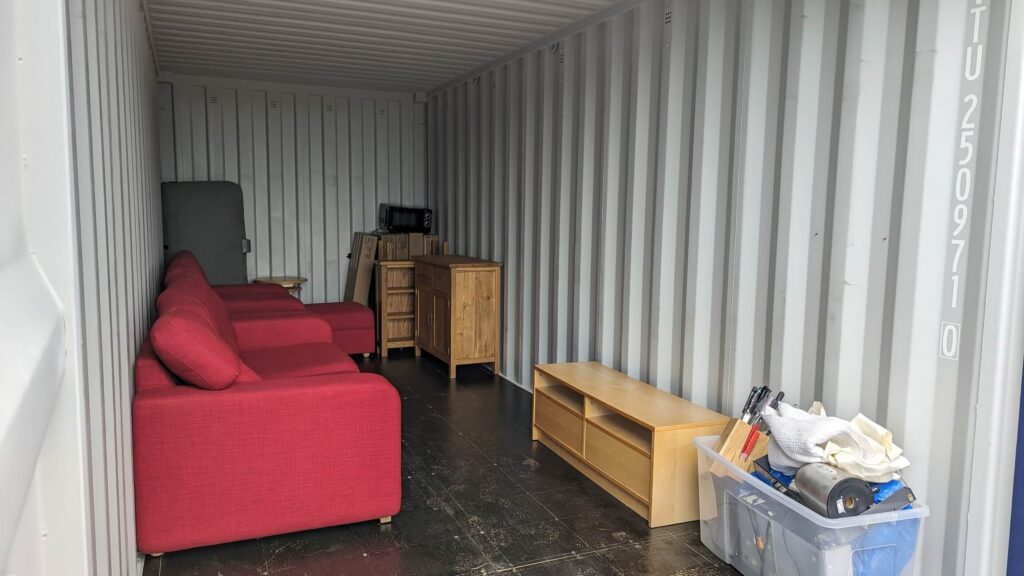A home renovation project can transform your living space, adding value, comfort, and functionality. However, the process comes with challenges, including dealing with clutter, protecting furniture, and keeping household items safe from dust, debris, and potential damage. Whether renovating a single room or the entire house, self-storage provides an efficient solution to declutter your space while ensuring convenience, flexibility, and secure transport of your belongings. With the proper logistics, self-storage helps manage furniture and construction materials while maintaining an organized environment.
At McDowell Mountain Community Storage, we understand the importance of securing your valuables during a renovation. With self-storage, you can free up rooms and areas, keep your belongings safe and organized. This guide will cover why self-storage is essential, how to choose the right storage unit, the advantage of using a box for packing, and organization tips to help manage a lot of items efficiently. Plus, we’ll explore storage solutions for different home renovation projects.
Why Use a Storage Unit for Home Renovation?
During a home renovation, your space becomes a construction zone filled with contractors, materials, tools, and debris. Storing your belongings in a self-storage unit is a brilliant idea to protect them from dust and damage. Storage has many benefits, such as keeping things organized and ensuring that important paper documents and fragile items remain safe. With the right approach, you can store anything securely while your renovation is underway. Having a secure storage unit to hold furniture, electronics, and personal belongings can simplify the process in many ways:
1. Protection Against Dust, Debris, and Damage
Home renovations generate dust and debris, which can settle on furniture, electronics, and artwork, leading to long-term damage. Using a self-storage unit ensures that your belongings remain in top condition, preventing scratches, dents, or exposure to humidity and temperature fluctuations. With the right options for packing, you can ensure nothing is left to chance. It’s a simple task that aligns with your contract and timeline, providing a safe pathway to store your items securely while the renovation progresses. Be sure to pack your belongings carefully to protect them during the process.
2. Extra Space for a More Efficient Workflow
Renovations often require open space for contractors, flooring installations, and cabinet replacements. Moving large furniture pieces like tables, appliances, and cabinets to a storage facility can free up valuable room for workers, ensuring a smooth process without unnecessary obstructions. Storing these items with the right plan in place can make the renovation feel like a breeze. If you have any questions about managing your items or the life of your renovation project, our team is here to assist you every step of the way.
3. Better Organization and Accessibility
Storing household items and construction materials in a rental facility allows for a structured approach to renovation. Instead of shifting furniture and boxes from one room to another, a well-organized storage unit keeps everything secure and accessible when needed.
4. Enhanced Safety for Homeowners and Workers
Leaving furniture, decor, and appliances in the middle of a renovation site increases the risk of damage and accidents. Self storage units keep fragile glassware, antiques, electronics, and tools out of harm’s way, reducing the likelihood of injuries for homeowners and contractors.
5. Peace of Mind During the Renovation Process
A clutter-free environment leads to a less stressful experience. Knowing that your valuable furniture, household items, and decor are protected in a secure storage facility allows you to focus on the renovation without constant worry.
What to Store During a Home Renovation?
Every home renovation project has different storage needs, but certain items should be kept away from the construction area to ensure their safety and condition.
1. Furniture & Home Decor
Items such as sofas, chairs, dining tables, artwork, and antiques should be stored to prevent scratches, dust accumulation, and potential damage. Bubble wrap, blankets, and secure packing methods help maintain their original condition.
2. Electronics & Appliances
Temperature-sensitive electronics like televisions, computers, and kitchen appliances need a climate-controlled storage unit to avoid damage from humidity and temperature changes. A storage facility with controlled conditions ensures your valuable gadgets remain functional.
3. Construction Materials & Tools
During renovations, construction materials like flooring, paint, cabinets, and supplies should be stored in a secure storage unit to keep them from getting lost or damaged. Proper storage solutions, such as shelving and labeled containers, can help organize these materials efficiently.
4. Household & Personal Belongings
Items such as clothing, books, essential documents, and seasonal decorations should be packed securely in boxes and stored away from the construction zone. This prevents them from getting lost in the renovation process.
5. Fragile Items: Glassware, Antiques & Artwork
Delicate items like glassware, antiques, and artwork require special handling during renovations. Bubble wrap, temperature-controlled units, and sturdy containers best protect these fragile possessions.

Choosing the Right Storage Unit for Your Home Renovation
The proper storage unit size, location, and amenities are essential to meet your renovation needs. Here are some factors to consider when choosing a storage facility:
1. Storage Size Guide: How Much Space Do You Need?
The proper storage unit size, as outlined in the storage unit size guide, depends on the furniture, belongings, and renovation materials you need to store.
- 5×5 Unit – Ideal for storing small furniture, boxes, and decor items.
- 5×10 Unit – Can accommodate appliances, chairs, or bedroom furniture.
- 10×10 Unit – Perfect for storing items from a one-bedroom apartment.
- 10×20 Unit – Best for storing multiple rooms’ belongings and furniture.
2. Climate-Controlled Storage Unit for Sensitive Items
A climate-controlled storage unit is recommended to store electronics, antiques, artwork, or essential documents. These units maintain stable temperature and humidity levels, ensuring the long-term protection of delicate contents.
3. Secure Storage Facilities & Convenient Location
Look for a storage facility with security features like surveillance cameras, gated access, and on-site management. A convenient location close to your home ensures easy access to your stored items throughout the renovation process.
4. Rental Facility Cost & Efficiency Considerations
The cost of a storage unit depends on unit sizes, amenities, and rental duration. Planning and choosing the right size unit can maximize efficiency and reduce costs.
Packing & Organization Tips for Self-Storage
Efficient packing, labeling, and organization can make self-storage easier and more effective. Here are some valuable tips:
1. Use High-Quality Packing Supplies
- Choose sturdy boxes for storing small items.
- Wrap furniture and decor in bubble wrap or blankets to prevent scratches.
- Use plastic containers for moisture-sensitive materials.
2. Label and Track Everything
- Keep an inventory list of all stored items.
- Label boxes with detailed descriptions to quickly locate contents.
- Arrange items by category for quick access.
3. Optimize Storage Space & Accessibility
- Stack boxes strategically, placing heavier boxes at the bottom.
- Store frequently used items at the front of the unit.
- Use shelving units for easy organization.
Storage Solutions for Different Renovation Scenarios
Depending on the type of home renovation project, your storage needs will vary.
1. Kitchen Renovation
A kitchen remodel requires storing appliances, cabinets, furniture, and cookware. Consider a self storage unit for these items until the project is complete.
2. Living Room or Bedroom Remodel
Store furniture, electronics, decor, and personal belongings in a climate-controlled storage unit to protect them from dust and damage.
3. Garage Renovation & Inventory Management
A garage renovation often involves clearing tools, storage bins, and furniture. A self-storage unit provides a temporary place to keep Everything secure.
4. Whole-House Renovation
A large-scale home renovation may require a variety of storage solutions. Choosing the proper storage unit size and using organizational strategies can help streamline the renovation process.
Final Thoughts
A well-planned self-storage solution can make your home renovation experience stress-free. From protecting belongings and furniture to creating extra space for contractors, using a storage unit is one of the best ways to simplify renovation.
Looking for a secure, convenient, and flexible self-storage unit? McDowell Mountain Community Storage offers storage solutions tailored to your needs, ensuring your belongings remain safe and accessible throughout your renovation.
Contact us today for the perfect self-storage unit for your next home renovation project!
Frequently Asked Questions
Explore our FAQs to learn how self-storage can simplify your renovation, from protecting valuables to choosing the right unit.
How Long Can I Keep My Belongings in a Self-Storage Unit?
You can rent a self-storage unit for as long as needed, whether for a few weeks or months, depending on the duration of your renovation. Most facilities offer flexible rental agreements, allowing you to extend storage as your renovation timeline evolves.
Can I Store Appliances in a Self-Storage Unit During a Renovation?
Storing large appliances such as refrigerators, washing machines, or dishwashers is possible. Prepare them by cleaning them and draining any water properly. For protection, wrap appliances in moving blankets to prevent scratches and dents.
What Should I Do if I Need to Change My Storage Unit Size During Renovation?
If your storage needs change during your renovation, you can switch to a larger or smaller unit based on availability. It is best to discuss your options with the facility in advance to ensure a unit fits your new requirements.
Is it possible to access my stored items outside of regular business hours?
Many self-storage facilities offer 24-hour access for an additional fee, allowing you to retrieve or store items whenever needed. Check with the storage facility for their access hours and inquire about any special arrangements they may offer for extended access.
How Do I Ensure My Items Are Covered by Insurance While in Storage?
It’s essential to check with the storage facility to see if they offer insurance for stored items. Some facilities provide insurance coverage as part of your rental agreement, while others may require you to arrange third-party insurance for high-value items.
Are there Any Restrictions on What Can Be Stored in a Self-Storage Unit During a Renovation?
Most self-storage units restrict the storage of hazardous materials, perishable goods, or illegal items. Be sure to check with your facility about its specific rules and guidelines, especially when storing chemicals, paint, or flammable materials.
How Can I Store My Valuables Like Jewelry or Important Documents?
Consider using a secure and climate-controlled storage unit for high-value items like jewelry or important documents. You may also opt for a safe deposit box or an additional insurance plan to protect them while in storage.
What Is the Cost of Renting a Self-Storage Unit for Home Renovation?
The cost of renting a self-storage unit can vary depending on its size, location, and additional features like climate control. It’s a good idea to compare pricing from different facilities and select one that fits your budget while providing the necessary features for your renovation.
Can I Use Self-Storage for Temporary Housing During a Home Renovation?
While self-storage units are designed for storing belongings, some people use them for temporary housing purposes, especially if renovations make living in the home impractical. However, it’s essential to check with your storage facility to ensure they allow this and that it’s appropriate for your needs.
What Are Some Tips for Storing Large or Bulky Items During a Renovation?
Plan your packing carefully for large or bulky items like furniture to maximize space. Use disassembly options (e.g., removing legs from tables), and wrap items with bubble wrap or protective blankets. Position heavy items at the bottom and lighter ones on top for stability during storage.


